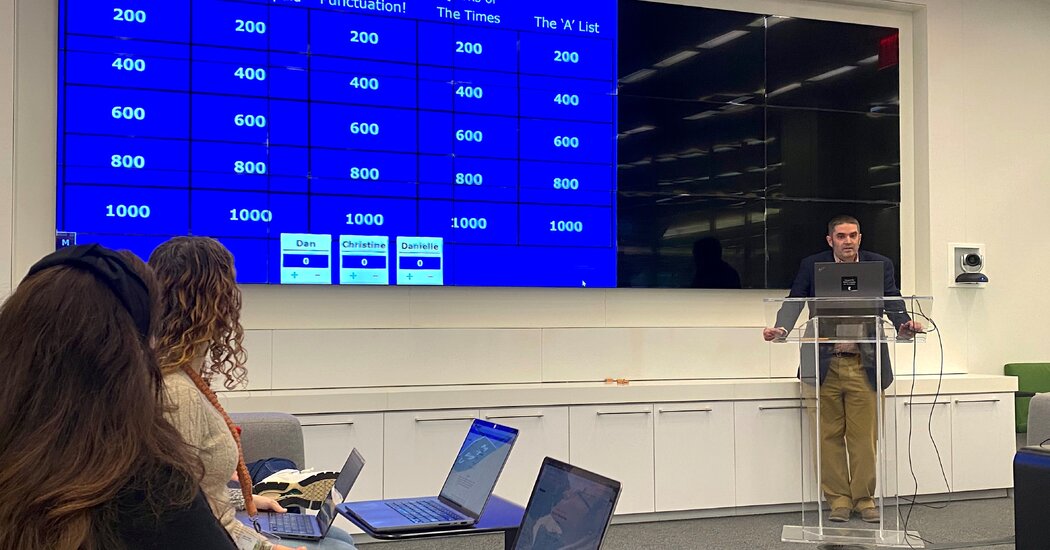Times Insider explains who we are and what we do and delivers behind-the-scenes insights into how our journalism comes together.
The clue appeared on a large blue screen: “In news writing, this punctuation mark is rarely needed except in quotations of shouted or deeply emotional phrases.”
A buzzer went off and an editor answered: What is an exclamation point?
“Yes!” Peter Blair responded. (The exclamation point is appropriate here. Mr. Blair did indeed shout.)
“Reporters in the room,” he added, “take notice.”
Perhaps Mr. Blair was excited because he was fulfilling something of a childhood dream by hosting a game show in the newsroom, to test contestants on their knowledge of The Times’s Manual of Style and Usage.
The manual, known in the newsroom as the stylebook, helps journalists keep track of grammar rules and Times style. Entries cover guidance on punctuation and semantics, but also offer instruction around The Times’s specific practices, such as the paper’s stance on courtesy titles and how numbers should be rendered in headlines.
The game was in the style of “Jeopardy!,” with categories such as “Quirks of The Times” and “Punctuation!” The contestants, the editors Danial Adkison, Christine Chun and Danielle Dowling, sat near the front of the room, buzzers in hand, and three other editors sat across from them, serving as the judges.
No real money was wagered; on the line were Starbucks gift cards.
Nonetheless, the pressure was on. The room was packed with a live audience, and about 170 Times staff members were watching the show via livestream.
Things heated up quickly, with a stumper appearing in the first round, under “The Trite Stuff,” for $600: “As a noun to mean fuss or controversy, this word is colloquial and trite.”
The contestants searched their brains for the right reply, lips pursed. A mechanism beeped, signaling that their time was up, and Mr. Blair revealed the answer: What is flap?
“We all learned something,” said Ms. Chun, an editor on the National desk.
As the editor of the Flexible Editing desk, Mr. Blair oversees a team that helps other desks with editing and staffing needs. He also trains editors who are new to The Times. He tries to make his trainings surprising and creative.
“I’m not somebody who likes to do a scripted training session,” he said.
The idea for the game show came to him last year as he was brainstorming fun ways to teach editors the stylebook. It was an excuse to live out a fantasy, too. When he was a child, Mr. Blair dreamed of becoming a game show host.
He shared the idea with Mike Abrams, a deputy Standards editor, who also runs internal trainings called Newsroom U. Then Mr. Blair drafted 51 clues based on stylebook entries. Three Times journalists participated in a test run, cameras and all, and shared feedback on the questions.
“I really wanted this to look professional and polished,” he said.
While he was finalizing the game, the contestants were studying. Hard.
Mr. Adkison, an editor on the Travel desk, read through what he considered the stylebook’s more esoteric entries, like those involving military titles. (A brigadier general, for example, wears one star, and the title is abbreviated as “Brig. Gen.” in news copy.)
Ms. Chun grilled herself on the entries she thought might appear in the game, like when to use “namesake” versus “eponymous.”
And Ms. Dowling, an editor who works for the newspaper’s print edition, spent some 10 hours reading the entire stylebook.
On the day of the contest, in April, one could argue that Mr. Adkison had a leg up: In 2012, he won three episodes of “Jeopardy!” — as in, the real game show.
That was “a pretty nerve-racking experience,” he shared between rounds with The Times’s audience. “This is actually much easier.”
Still, his competitors gave him a run for his Starbucks money. And it was a close game, until it wasn’t. Going into the final round, Mr. Adkison was ahead by some $6,000.
The last question was a doozy: “If a word appears neither in the Times stylebook nor in Webster’s New World College Dictionary, consult the latest printing of Webster’s Third New International Unabridged Dictionary, but only for this.”
What is spelling? Both Mr. Adkison and Ms. Dowling answered correctly, but Mr. Adkison’s score climbed to $15,601.
“With that, you are now a four-time ‘Jeopardy!’ champion,” Mr. Blair declared.
Though the competitors were playing in the company of their colleagues — not a national audience — they still felt nervous. “My hands were still shaking for like a good half-hour after,” said Ms. Chun.
The buzzer was often a source of tension, either because contestants buzzed in too quickly or too late. “I was jumping the gun too many times,” Ms. Dowling said.
While the event was all in good fun, Ms. Dowling signed up partly to brush up on the stylebook, despite the fact that she checks it during every shift. “It’s just vital,” she said, adding that English grammar is “rather thorny.”
Ms. Chun also wanted to learn. “I realized there’s still so much more in the stylebook that I did not know,” she said.
Editors are encouraged to familiarize themselves with the guide, but it is not exactly an edict, Mr. Blair said. Exceptions are made, and the rules evolve. (One of the game’s categories was “Deleted Guidance.”) Yet all of the contestants believe the stylebook is crucial in maintaining consistency. It helps Times journalists uphold a high standard, and strive to make the writing as clear as possible.
“Ultimately, like everything we do here,” Mr. Adkison said, “it’s really to make the reader experience better.”
Sara Aridi is a Times journalism education editor helping to explore partnerships with The School of The New York Times.
The post What Is … an Editing Game Show? appeared first on New York Times.




